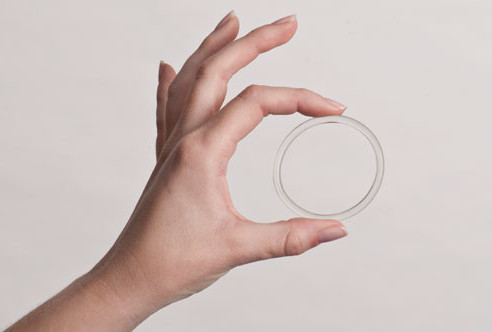The vaginal ring, most commonly known as the NuvaRing®, is a soft, flexible ring that is inserted into the vagina once a month for three weeks to prevent pregnancy.

Table of Contents
How Does the Vaginal Ring Work?
The vaginal ring is a form of birth control that steadily releases both estrogen and progestin hormones, similar to the combination pill. The vaginal hormonal ring is inserted into the vagina similar to a tampon. It is about 2.1 inches (54 mm) in diameter, and is left in the vagina for three weeks, and remains in place during vaginal intercourse. After the third week, the vaginal ring is removed for one week, during which time the female will usually have her period. At the end of the week, a fresh, new ring is inserted.1 The NuvaRing® works by preventing sperm from meeting an egg. The hormones released by the ring are absorbed by the vaginal walls, and stop ovulation from occurring. The hormones also thicken the mucus lining of the cervix, making it more difficult for sperm to reach an egg. The NuvaRing is a reversible form of contraception, which means fertility returns very soon after stopping use of the ring.2
Effectiveness of the Vaginal Ring
With perfect use the NuvaRing is 99% effective, but with typical use, the ring is about 91% effective. Factors such as proper insertion of the ring and consistent timing of insertion increase how effective the ring is at preventing pregnancy. However, it is important to note that there is a very small chance that a user could still get pregnant, even with perfect use.2
Vaginal Ring Insertion
The vaginal ring is a self-administered contraceptive. The exact positioning of the ring is not critical for it to be effective since it does not work as a barrier. The following is a list of steps to follow when inserting a vaginal ring:3
1. Insertion should occur within the first five days of a female’s menstrual period, or else a backup method of birth control should be used during sexual activity for the first seven days after insertion. Be sure to check the expiration date of the ring package.
2. Wash and dry hands thoroughly.
3. Find a comfortable position either lying down, standing with one leg propped up, or squatting.
4. Press the sides of the ring together between your thumb and index finger.
5. Insert the ring into the vagina. If discomfort is felt, use a finger to push the ring higher up the vagina. The cervix will serve as a barrier to prevent the ring from moving too far up.
7. Remove the ring after three weeks by hooking the ring with a finger and pulling it out. Dispose of the ring in the trash, ensuring that it is out of reach from children and pets.
8. After seven days without the ring, be sure to insert a new ring on the same day of the week as the previous insertion (e.g. placing the ring in on Sundays).
The ring may slip out at any point during the three weeks. If that happens, rinse it with warm water and replace it within three hours to prevent pregnancy. Two months worth of vaginal rings may be used back-to-back to allow the female to skip her menstrual period.
Sex with the Vaginal Ring
According to NuvaRing®, most of their users do not feel the ring once it is in place.4 The ring may move slightly when it is in the vagina, but it should not cause discomfort. If it does, it is probably not fully inserted, so you can gently adjust it with your finger. Try to push the NuvaRing as far as you can into the vagina to ensure its proper placement. Very few females or their partners report feeling the NuvaRing during intercourse. According to NuvaRing®, in clinical studies 9 out of 10 partners did not find this to be a problem.
Advantages
The vaginal ring releases fewer hormones than the average hormonal pill, and many users find it more convenient because it requires only one insertion and removal every month. Many users experience the same benefits as the pill, such as shorter, lighter periods, less acne, and reduced risk of pelvic inflammatory disease.
Disadvantages

The vaginal ring does not protect against the transmission of HIV or any other STIs, so we recommend using a barrier form of birth control along with the ring. When storing the ring for longer than a couple of months, users must remember to refrigerate the unused rings to maintain their effectiveness. It is also important for users to pay attention to the whereabouts of the ring because the walls of the vagina tend to lift and open when sexually aroused, so it is possible for the vaginal ring to fall out during sex.
The ring may irritate the vagina or cause an increase in discharge. Other side effects can also include breast tenderness, nausea, headaches or breakthrough bleeding. Side effects may be most noticeable within the first few months of use but should subside over time. Be sure to inform your healthcare provider if you have any heart conditions, blood clots, certain cancers, a history of stroke or heart attack, smoke or may be pregnant.2
Concluding Remarks
While the NuvaRing is an effective and convenient form of pregnancy prevention, there are pros and cons to every form of birth control. We recommend discussing your options with your physician so they can help determine what kind of birth control would work best for you.
For more information on the vaginal ring, watch below!
References
- LeVay, Simon, Janice I. Baldwin, and John D. Baldwin. “Contraception and Abortion.” Discovering Human Sexuality. New York, NY: Oxford UP, 2019. 282-83. Print.
- Parenthood, Planned. “NuvaRing | Birth Control Vaginal Ring | Estrogen Ring.” Planned Parenthood. N.p., n.d. Web. 14 Oct. 2018.
- “Vaginal Ring – What You Need to Know.” Drugs.com. Drugs.com, n.d. Web. 14 Oct. 2018.
- “NuvaRing® (etonogestrel/ethinyl Estradiol Vaginal Ring) ǀ Official Site.” NuvaRing® (etonogestrel/ethinyl Estradiol Vaginal Ring). N.p., n.d. Web. 14 Oct. 2018.
Last Updated: 1 November 2018.
